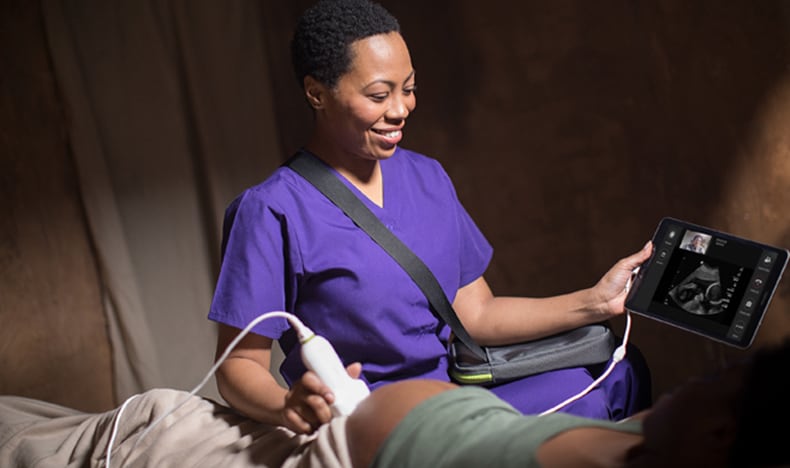Innovating for patients and planet: driving equitable and sustainable healthcare
Sep 14, 2023 | 10 minute read


What do we mean by ‘equitable and sustainable healthcare’?
Equitable healthcare is not just about ensuring the availability of care: it’s also about tackling broader barriers, like health education and physical distance from hospitals. Health technology companies like Philips play a vital role as innovators and drivers of digital transformation. How? By connecting more patients to the care they need, while at the same time making it easier and more efficient for healthcare professionals to provide care. For healthcare to be truly equitable, it also must be sustainable. Ironically, the world’s healthcare systems are responsible for over 4% of global carbon emissions – more than the aviation or shipping sectors – and generate vast amounts of waste. [2] Since 1946, the right to health (including access to care, safe drinking water, and adequate housing) has been internationally recognized as a fundamental human right. And in 2022 the United Nations General Assembly unanimously affirmed a clean, healthy, and sustainable environment as a human right. The reality that human health and environmental health are inextricably linked is central to sustainable healthcare. It is all about delivering quality care to those who need it when they need it, while minimizing environmental impact by: In the short term, harmful climate effects will worsen existing health inequities and exact an increasingly high human toll. As an industry, we have a responsibility to act with urgency.

Innovating for social impact and environmental sustainability
Those involved in developing new technologies need to fully understand existing needs on the ground and how a solution will be used in practice. Listening to diverse voices – particularly patients and care providers – and teaming up with local partners, governments and communities can generate better outcomes and avoid developing solutions that in practice prove inaccessible, ineffective, or unsustainable. At Philips, we are committed to doing business with sustainable impact, making sure that the choices we make are the right ones for patients, healthcare professionals, the planet, and the wider society. As a health technology company, we believe that innovation – viewed through the lens of customer needs – can improve health and healthcare outcomes, patient and staff experience, and productivity, as well as make care more accessible, connected and sustainable. For example, we are responsibly embedding AI and data science in our propositions – e.g. applying the power of predictive data analytics and artificial intelligence at the point of care – to aid clinical decision making, expand healthcare access, and improve the quality and efficiency of healthcare services. Teaming up with our customers, suppliers, and industry peers, we are striving to innovate solutions that expand access and improve the quality and efficiency of care, without further depleting the Earth’s resources. The ultimate aim being to go beyond ‘impact-neutral’ through regenerative innovation and design.
Our innovation processes focus not only on products, but also on business models. For example, new models of care delivery, such as Ambulatory Care Centers, which bring specialty care closer to patients, and Enterprise Monitoring as a Service, which offers hospitals the advanced patient monitoring functionality they need without upfront capital expenditure.

Solutions to advance equitable healthcare
While a person’s geographic location and socioeconomic status are outside the direct control of a health technology company, innovators can design in ways that recognize and help address social determinants of health. At Philips, we are dedicated to advancing health equity and improving access to care through our cutting-edge health technology innovations – targeting communities where health disparities are most pronounced and where our interventions can make a significant impact. Mobile solutions offer new ways to bring critical care closer to patients. In Australia, for example, nearly 30% of the population lives in regional and rural areas. [3] People often have to take time off work and arrange for transportation to seek the care they need in urban/metro areas. Add to that the issue of affordability, and the result is that people often neglect seeking timely care. Working with Heart of Australia, Philips helped create a ‘hospital on wheels’ capable of bringing diagnostic imaging services, such as X-ray and CT, to hard-to-reach communities. Understanding the needs of specific populations and co-creating with health ecosystem partners helps technology companies innovate more equitable and sustainable solutions. Technologies such as mobile ultrasound with AI support and mobile apps hold real promise for closing care gaps in maternal and child health. One of our newest innovation ventures, a collaboration with the Bill and Melinda Gates Foundation, aims to improve pregnancy outcomes by developing artificial intelligence (AI) for the Lumify tablet-based ultrasound to enable healthcare professionals, such as nurses and midwives, to better perform obstetric ultrasound. This innovation has the potential to improve maternal care – especially for women living in remote and underserved areas.
In the US, Philips has teamed up with Emory University and other local partners to extend healthcare access to Georgia's vital and vulnerable farmworker population. This large and transitory population often encounters health hazards and daunting barriers to care, including communication gaps and lack of insurance and transportation. In addition to providing care for the farmworker community, the Farm Worker Family Health Program also offers nursing students hands-on experience with innovative Philips technologies, such as the Philips Lumify Handheld Ultrasound, and access to the lifesaving Philips HeartStart AED.

Driving sustainable healthcare
At Philips, we embed environmental sustainability in our innovation processes through EcoDesign. This means improving the energy efficiency of our products, using less resources and materials, and more recycled content, avoiding the use of hazardous substances, designing for circularity, and making our packaging easier to recycle and re-use. To give just two examples of the resource and energy efficiency we are driving: our MRI scanners with fully sealed, helium-free-for-life BlueSeal magnet technology, have already saved over 1 million liters of helium, a vital yet scarce resource. [4] And our IntelliVue MX40 wearable patient monitor offers a 92% reduction in power usage compared to its predecessor. By innovating together with care providers and suppliers, we can scale sustainable practices to reduce healthcare’s carbon footprint. Besides EcoDesign and service models, these include lifetime extension programs, workflow optimization through digitalization, circular financing solutions with equipment take-back, and responsible end-of-use management to avoid waste going to landfill. We are also innovating cloud-, service- and software-based solutions that make it possible to treat more patients, e.g. by supporting remote care delivery. The shift from resource-intensive clinical facilities to lower-cost settings and the home has the benefit of expanding access to care while also avoiding appointment-related travel and CO2 emissions.

Join the movement to transform healthcare for a better tomorrow
I referred in the introduction to the significant challenges healthcare is facing. Yet I firmly believe that challenges are the mother of invention. Innovation can enable us to address both social and environmental issues – designing products, services and experiences that improve the health and well-being of all people, not just the lucky minority, while protecting the planet and its natural resources. When it comes to building tomorrow’s health systems, it is my sincere hope that, going forward, strategic, economic and financial decisions are based – from the outset – on a shared recognition of the need for health equity and sustainable and regenerative use of resources. This demands concerted action across the healthcare ecosystem. Only by working together can public and private stakeholders, companies, governments, NGOs and peer organizations build the momentum and sense of urgency needed to realize systemic change and global impact – driving digital transformation, taking climate action, reversing biodiversity loss – and so help deliver equitable and sustainable healthcare. There can be no doubt that we are at a defining moment where we need to pull out all the stops. Fresh thinking, innovative approaches, and a willingness to share learnings are required in every aspect of healthcare – procurement, supply chain, collaboration, regulation, etc. – if we are to effect an industry reset and successfully deploy game-changing solutions at scale. Keen to learn from others’ best practices, I would love to hear what your organization is doing to help realize this goal.
Sources:
[1] 2023 Global health care sector outlook | Deloitte
[2] Health Care Without Harm (2019). Healthcare’s climate footprint: How the health sector contributes to the global climate crisis and opportunities for action (p.22). https://noharm-global.org/documents/health-care-climate-footprint-report
[3] Australian Institute of Health and Welfare, Rural and remote health. July 2022
[4] Total helium saved compared to conventional, helium-cooled scanners across both production and operations since 2018
Share this page with your network













